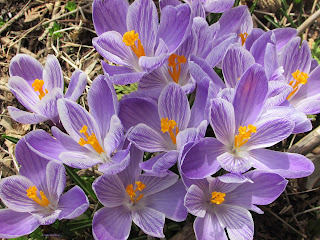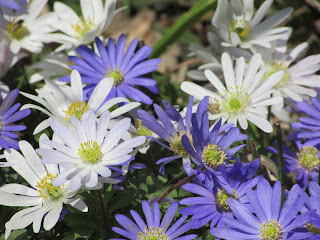Hi gardeners
 |
| This beautiful tropical hibiscus blooms inside all winter |
Tomorrow is fall equinox and for many of us it means time to think about moving the gardening activities inside. A house is not a home without plants inside. I will begin working on the job tomorrow as we are in for some cool wet weather. I am not looking forward to all the lifting and carrying to bring my jungle inside, but I am usually pleased when it's done. Most of my houseplants go outside for summer and as it starts getting colder, vacation time for them is over. It's always quite the task to find room for all of them as they grow bigger each year and I always add something new each year I want to save.
Many people seem to be confused as to what plants in the garden you can save and winter inside. So I have written this article to help guide you in choosing which plants to save.
What Garden Plants Can I Save for Next Year?
If you are in zone 6 or lower you are probably thinking
about bringing in the houseplants and it’s time to do so. Most gardeners in
planting zones 6 and lower will experience frost before October 15, in an average
year. Your houseplants and any garden plants you want to save must be brought inside before frost or freezing temperatures.
Of course, you will bring your tropical houseplants inside
but there are many other plants you can bring inside that will overwinter and
you won’t have to purchase them again next year. Some tender perennials that
are over-wintered inside become large, attractive plants that would be
impossible to obtain with one summer’s growth outside.
True annual plants are plants that complete their life cycle
in a single year. These plants won’t do well indoors and should be allowed to
perish, despite how pretty they look. You may be able to cover them through a
few frosts to prolong their outside life. These plants include marigolds,
zinnias, cosmos, tithonia, nasturtiums, morning glories, sweet alyssum,
sunflowers, dill, and basil.
Petunias and million bells (calibrachoa) are actually
tender perennials (see below) but plants that have been growing outside all
summer don’t do well when brought inside. You could try rooting a few cuttings
to bring inside if you really want to save them.
Tender perennials are often plants we treat like annuals,
allowing them to die with the first frost or at least a freeze. Many people
don’t realize that some of these common garden plants are really perennials and
if wintered inside will last for years.
Plants that can be overwintered inside at normal room
temperatures and enjoyed all winter are below. These plants need temperatures
that stay above 55 degrees, bright light and moderate watering over winter.
Abutilon,
agaves,
allamanda,
 |
| These two pots, ginger and begonias on the left and fuchsia and begonias on the right could be brought inside as is or the plants could be potted separately. |
aloes,
begonias (fibrous rooted and cane type),
bougainvillea,
coleus,
echeveria,
eucalyptus,
fuchsia,
gardenias,
ginger lilies,
goldfish plant,
hibiscus (tropical),
impatiens,
Joseph’s coat (Alternathera
ficoidea),
kalanchoes,
kangaroo paws,
lantana,
lemon grass,
lemon verbena,
lipstick plant,
livesaver plant (Huernia
zebrina),
 |
| Setcreasea pallida |
mandevilla
oxalis,
polka dot plants,
ornamental peppers,
rex begonias,
“spikes” (dracaenas),
sensitive plant,
Setcreasea pallida 'Purple Heart',
sweet bay,
sweet potato vines
Tender fruiting plants like the various citrus family
members, papaya, pomegranate, and figs that aren’t hardy to your area can be
wintered inside in warm conditions. Pomegranate and some figs may lose leaves
and go semi-dormant in mid-winter.
Note: the category “succulents” covers many species
of plants with many different needs. Some can be planted outside even in colder
zones, some need winter dormancy and some do not. Some will do nicely inside, others won’t. You
need to find out the species of succulent you have to know what its winter
requirements are.
Garden geraniums (pelargoniums) are a special
case. You can bring them into a warm
bright room, and they will bloom all winter. Or you can let them go dormant in
a cool place.
Instead of bringing whole plants inside you can sometimes
take cuttings of plants and over winter small plants you start from them. It is better to start these plants outside in
late summer, and then bring in the small pots before frost. However, if frost threatens
and it seems to be too much work to bring a large plant inside, take a few
cuttings and try your luck.
 |
| This pretty ivy geranium can bloom inside all winter |
Plants that need protected dormancy
There are other plants that you may want to overwinter
inside in a cool spot. These will go dormant but will start growing again in
spring when placed outside. These are plants that need some winter chill or
resting period to grow well but can’t survive the cold of northern winters
(zone 6 and below).
A cool spot is one above freezing, the low 40’s are ideal. The
pots will need occasional watering but shouldn’t get too wet. Some plants will
lose their leaves and that’s fine. Once the leaves have died on some of these,
they won’t need much water at all. An unheated attached garage or unheated
porch or basement may be a good place for these. They should not be allowed to freeze.
Plants that need some dormancy or can tolerate it for winter
storage include;
Argyranthemum,
 |
| I let brugmansia continue to bloom inside for a month or so, then move them to cool, dormant storage |
brugmansia,
diascia,
Iochroma,
jasmine,
rosemary,
perennial reeds, sedges and grasses not hardy to your zone,
perennial salvias not hardy to your zone,
passionfruit vines.
Potted mums you used for fall decorations can be trimmed
back to about 3 inches after blooming stops and overwintered in a cool place.
In spring they will start growing again and can be planted in the ground
outside. Many will survive the next winter in the ground.
Vegetable and herb
plants
It’s true that
tomatoes and peppers are perennial plants. But don’t try to overwinter the ones
that grew in your garden, these will usually succumb to fungal diseases they
picked up outside and are just too difficult to acclimate to indoor
conditions. Instead start new plants
from seed in late summer – somewhere away from your garden plants or inside.
You will need a grow light for success with these.
Don’t try bringing
other vegetables inside. Under a grow light you can grow salad greens inside
but start them from seed indoors. Chives can be potted and brought inside and
will grow on a sunny windowsill or under grow lights, but most other herbs do
not like indoor conditions. Sometimes basil can be grown from seed but often
has disease problems inside. Some newly started thymes and mint may grow for a
while under grow lights.
Lavender, sage,
oregano, and rosemary do not like warm indoor conditions. They can overwinter
in cool dormancy.
Tender bulbs and
tubers
Bring these bulbs or tubers into a cool but not freezing
area, with natural daylight, and leave the bulbs in pots to die back. After the
foliage dies cease watering, keep above freezing, and then begin watering again
in March, and place in full sun.
Caladiums,
calla lilies,
Colocasia- (elephant’s ears and taro),
 |
| Leave calla lilies in their pots to die back, then store. |
Eucomis- (pineapple lilies)
peacock orchids,
rain lilies,
tuberous begonias
Other tender bulbs like cannas, glads, dahlias, crocosmia,
etc. can be dug after a light frost kills the foliage and stored dry, with foliage
cut off, in peat moss, sand, wood shavings or vermiculite. They must be dug before a hard freeze.
What not to bring
inside
Besides the true
annuals and most vegetables listed at the beginning of the article don’t bring
perennials that are hardy to colder zones (7 and below) inside for winter. They need cold dormancy to survive. As
mentioned above you can sometimes protect perennials that aren’t winter hardy
to your zone but try to avoid purchasing plants that aren’t winter hardy where
you live. These plants cannot be wintered in warm conditions. It can be tricky
to give them enough cold but not too much cold.
Don’t bring in
deciduous trees and shrubs, evergreen trees and shrubs, roses, fruit trees such
as apples, pears, peaches and cherries, nut trees, raspberries, blackberries,
blueberries, and grapes. Strawberries can be grown inside under grow lights but
use newly started plants, don’t dig up garden plants. They won’t grow well on
windowsills. Some mini roses are sold for inside growing, but don’t bring in
garden roses. “Native” plants should not be brought inside for winter.
Most water plants don’t do well inside either. Like succulents each species has different
requirements, and you need to know the conditions for winter these species
prefer. If the water plant is hardy in your zone in a natural pond it probably
won’t do well inside because it needs winter dormancy. Some tropical water
plants may overwinter inside, but it’s hard to maintain the right conditions
for them. I have tried to overwinter water hyacinths several times with no
luck.
Preparation
If the plants you want to save are growing in the ground
they should be dug up and carefully potted. If they are crammed into a
container with other plants, it would be wise to separate the different plants
and pot them separately.
Plants that are in containers that aren’t crowded can be
brought inside in the pots they were growing in. Check the plants and the pots
carefully so you don’t bring in small surprise guests like frogs and mice. Use
a good, lightweight potting soil if you need to re-pot tender perennials you
are bringing inside.
Some insects can become a big problem indoors if they hitch
a ride inside. It is a good idea to spray plants with an insecticide or use a
systemic insecticide on them the day before you bring them inside. If you do it outside you won’t pollute your
indoor air and surfaces. And the
insecticides won’t impact pollinators inside your home. However, if you have
pets that munch on leaves indoors you may want to skip the insecticide.
Don’t try to save too many tender perennials unless you have
a big greenhouse. (Even I close my eyes and leave some behind.) Just save the
most expensive, rarest or your personal favorites. You can propagate cuttings from one or two
plants for a new border of impatiens rather than trying to save the whole
border. All plants need room and good light and the more you have, the more
time you will spend caring for them. Trust me, I know.
Kim Willis
Copyright 2021 - This article is not to be reproduced without permission






